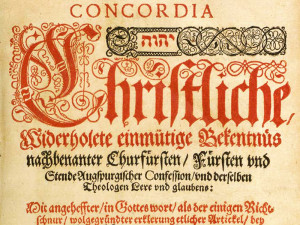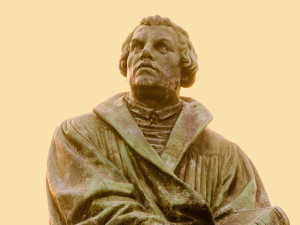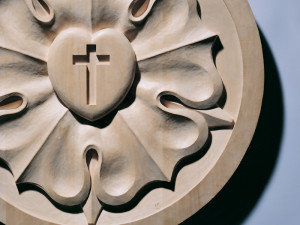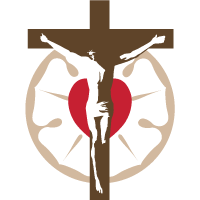by Rev. Aaron Moldenhauer
 Throughout the Reformation, calls for a general council of the church to discuss religious issues were discussed and negotiated. One instance of these negotiations came in 1536, when Pope Paul III called for a council to begin in 1537. The Lutherans, wary of submitting themselves to a council that would be stacked against them, discussed how they might respond to Paul’s call for a council. Part of the Lutheran response was to prepare a written statement of their theological position. The Lutheran Elector John Frederick of Saxony gave Luther the assignment of drafting that position. And so, in late 1536, Luther began to write the Smalcald Articles as part of the Lutheran preparation for a general church council.[1]
Throughout the Reformation, calls for a general council of the church to discuss religious issues were discussed and negotiated. One instance of these negotiations came in 1536, when Pope Paul III called for a council to begin in 1537. The Lutherans, wary of submitting themselves to a council that would be stacked against them, discussed how they might respond to Paul’s call for a council. Part of the Lutheran response was to prepare a written statement of their theological position. The Lutheran Elector John Frederick of Saxony gave Luther the assignment of drafting that position. And so, in late 1536, Luther began to write the Smalcald Articles as part of the Lutheran preparation for a general church council.[1]
Luther also intended the Smalcald Articles to be his own theological last will and testament. He feared that his teaching would be misrepresented by others, and that he would soon die.[2] As we read the Smalcard Articles, we see Luther’s considered view of the Christian faith that he intended to be his enduring testimony.
Luther divides the Smalcald Articles into three parts. The first part is an affirmation of credal confessions of the Trinity and incarnation—points on which the Lutherans and the Roman church agreed. The second part refers to the office and work of Jesus Christ, redemption. Luther arranges this part to list those doctrines that were central and could not be denied, regardless of what a council said. The third part is a treatment of doctrines that the Lutherans could discuss with “learned and reasonable people.”[3]
The “first and chief article” appears at the beginning of the second part, listing non-negotiable doctrines. But before we consider Luther’s chief article, ask yourself: If you were writing your final testimony about the Christian faith, what would you identify as the first and chief article? The answer to the question reveals what lies at the heart of anyone’s understanding of God and Christianity. Luther’s answer is:
 “The first and chief article is this:
“The first and chief article is this:
Jesus Christ, our God and Lord, died for our sins and was raised again for our justification (Romans 4:24-25).
He alone is the Lamb of God who takes away the sins of the world (John 1:29), and God has laid upon Him the iniquities of us all (Isaiah 53:6).
All have sinned and are justified freely, without their own works or merits, by His grace, through the redemption that is in Christ Jesus, in His blood (Romans 3:23-25).
This is necessary to believe. This cannot be otherwise acquired or grasped by any work, law, or merit. Therefore it is clear and certain that this faith alone justifies us. As St. Paul says:
For we hold that one is justified by faith apart from works of the law. (Romans 3:28)
That He might be just and the justifier of the one who has faith in Jesus. [Romans 3:26]
Nothing of this article can be yielded or surrendered, even though heaven and earth and everything else falls [Mark 13:31].
For there is no other name under heaven given among men by which we must be saved. (Acts 4:12)
And with His stripes we are healed. (Isaiah 53:5)
Upon this article everything that we teach and practice depends, in opposition to the pope, the devil, and the whole world. Therefore, we must be certain and not doubt this doctrine. Otherwise, all is lost, and the pope, the devil, and all adversaries win the victory and the right over us.”[4]
 Three observations: First, while Luther identifies this as the “first and chief article,” it is not the first article in the Smalcald Articles. The “first” here refers not to the outline of the document, but to the primacy of this article in relation to other doctrines. The first part of the Smalcald Articles affirms the Trinity and the incarnation, as confessed in the Apostle’s and Athanasian Creeds. The chief article on redemption builds on this confession of the Trinity and the person of Christ.
Three observations: First, while Luther identifies this as the “first and chief article,” it is not the first article in the Smalcald Articles. The “first” here refers not to the outline of the document, but to the primacy of this article in relation to other doctrines. The first part of the Smalcald Articles affirms the Trinity and the incarnation, as confessed in the Apostle’s and Athanasian Creeds. The chief article on redemption builds on this confession of the Trinity and the person of Christ.
Second, Luther’s first and chief article highlights Christ at the heart of Christianity. Christ and his work precede faith. Luther’s chief article begins with Christ’s death and resurrection, his bearing sin and redemption. Then Luther discusses faith as the means by which Christ’s work of redemption is received, excluding works and merit from the article of justification. Luther returns to Christ as the only way to salvation, quoting Peter’s statement in Acts that in Jesus’ name alone we find salvation, and Isaiah’s prophecy that by his stripes we are healed. This doctrine of redemption won by Jesus Christ and received through faith cannot be compromised.
Third, Luther’s point that the chief article excludes works, law, and merit from justification is developed throughout the Smalcald Articles. Luther uses this chief article as a diagnostic tool to consider church practices and beliefs. For instance, Luther critiques the Mass, monasticism, and the papacy in light of the chief article.[5] Beyond numerous explicit references to the chief article, even more implicit references appear in the Smalcald Articles. That is, an ignorance of Christ, our Savior contributes to a poor understanding of sin.[6] Repentance goes wrong when it includes no mention of Christ.[7] The right relationship between faith and good works is approached by repeating what Luther has said about justification.[8]
 This diagnostic use of the chief article points to the ongoing relevance of the Smalcald Articles today. Luther’s first and chief article still functions as a diagnostic tool. We do well to use it to evaluate theological movements and practices that have arisen since the sixteenth century. Those that deny Christ’s work, put human traditions as requirements for justification, or displace redemption with some other central theological aim are deficient. With Luther, we ought to stand on the first and chief article of Christ’s redemption and justification by faith.
This diagnostic use of the chief article points to the ongoing relevance of the Smalcald Articles today. Luther’s first and chief article still functions as a diagnostic tool. We do well to use it to evaluate theological movements and practices that have arisen since the sixteenth century. Those that deny Christ’s work, put human traditions as requirements for justification, or displace redemption with some other central theological aim are deficient. With Luther, we ought to stand on the first and chief article of Christ’s redemption and justification by faith.
The Rev. Aaron Moldenhauer is associate pastor of Zion Lutheran Church, Beecher, Ill.
[1] Martin Brecht, Martin Luther: The Preservation of the Church 1532-1546, trans. James L. Schaaf, 1st paperback edition (Minneapolis: Fortress Press, 1999), 178-185.
[2] Smalcald Articles, Preface.
[3] Smalcald Articles, Part III, Introduction. This and subsequent quotations are taken from Paul McCain et al., eds., Concordia: The Lutheran Confessions A Reader’s Edition of the Book of Concord, 2nd ed. (St. Louis: Concordia Publishing House, 2006).
[4] Smalcald Articles II, I, 1-5.
[5] Smalcald Articles II, II, 1; Smalcald Articles II, III, 2; Smalcald Articles II, IV, 3.
[6] Smalcald Articles III, I, 11.
[7] Smalcald Articles III, III, 14, 20, 23.
[8] Smalcald Articles III, XIII, 1-4.
